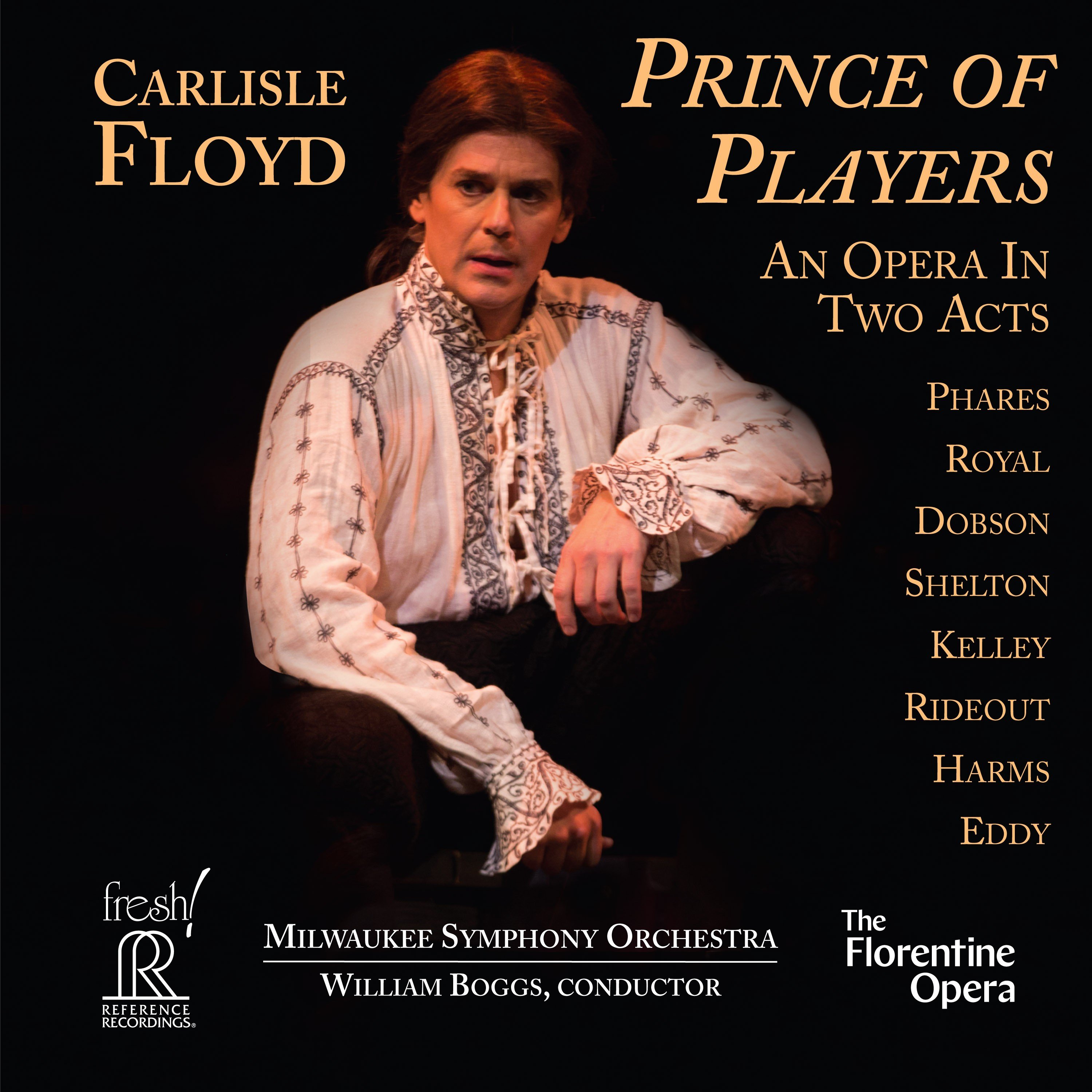OPERA SEARCH
Prince of Players
(2014-16)Carlisle Floyd (E)
3S,3M,5T,Bar,2BBar,mimes; mixed chorus;
2(II=picc).2(II=corA).2(II=bcl).2(II=dbn)-2.2.0.0-timp.perc:SD/cym/TD/tamb/wdbl-harp-strings
Abbreviations (PDF)
Boosey & Hawkes
Wortham Theater Center, Houston, TX
Michael Gieleta, director
Conductor: Patrick Summers
Company: Houston Grand Opera
| Edward Kynaston | Baritone |
| Thomas Betterton | Bass-Baritone |
| Villiers, Duke of Buckingham | Tenor |
| Margaret Hughes | Soprano |
| Lady Meresvale | Mezzo-Soprano |
| Miss Frayne | Soprano |
| Sir Charles Sedley | Tenor |
| Charles II | Tenor |
| Nell Gwynn | Soprano |
| Hyde | Bass-Baritone |
| Male Emilia | Tenor |
| Female Emilia | Mezzo-Soprano |
| Stage Hand | Tenor |
| Mistress Revels | Mezzo-Soprano |
| Ruffians | Non-Speaking |
| Chorus of Audience Members (theater & pub) | |
| Chorus of Guests |
1661, London
Setting: London, 1661
Edward Kynaston, a renowned “boy player” (a specialist in female roles at a time when it is illegal for women to perform onstage) performs the role of Desdemona in Othello to a wildly appreciative audience at Duke’s Theater. Backstage after the performance, the artists are presented to King Charles II and his mistress, Nell Gwynn. Two ladies invite Kynaston to join them for a stroll in St. James’s Park, where all three are mistaken for prostitutes by Sir Charles Sedley. Kynaston, still in his Desdemona costume, leads Sedley on before vulgarly revealing that he is a man. Infuriated, Sedley vows revenge.
Kynaston attends a banquet with his lover, George Villiers, Duke of Buckingham, at King Charles’s palace. Kynaston’s dresser, Margaret Hughes (Peg) attends with Sedley, her uncle. Nell Gwynn, who desires a performance career herself, hails Peg as the first woman on the English stage because of a recent pub performance. Wishing to please Nell, and despite Kynaston’s desperate attempt to persuade him otherwise, the king issues an edict allowing women to perform onstage and forbidding men to act women’s roles.
The law soon takes effect, and Kynaston finds it impossible to transition to male roles. He has lost not only his living but also his wealthy lover, who is soon to be married. In desperation, he takes a job performing at a bawdy tavern. Peg follows him there and is heartbroken to see his degradation. She is taking him home when they are accosted by thugs sent by Sedley. Kynaston is badly beaten.
Peg takes care of Kynaston as he recovers. She confesses she loves him and has learned everything she knows about acting by watching him. Out of curiosity, he asks her how she handles Desdemona’s death scene, as he has always found his interpretation lacking. She admits she plays it the same way he did, but that she finds it too lacking in realism and passion. Aroused by the moment of intimacy, they begin to make love.
A few days later at Duke’s Theatre, Peg refuses to act in a royal command performance of Othello unless Kynaston himself restages the death scene. He agrees and also steps into the title role. Together they strip away conventions and create a performance of breathtaking power.
“…it is the story of Edward Kynaston, one of the last men to play women’s roles on the stage in Restoration England. Charles II’s edict that female parts must henceforth be played by women means that the 26-year-old actor, once the toast of London, is not only out of work, but his whole being, including his sexuality, is called into question… The emotion of a man living the wrong life is carried in the autumnal, transparent orchestration, in which wistful woodwind solos evoke the protagonist’s feminine world.”
Wall Street Journal
“During Kynaston’s transformative journey from artifice to realism, he goes from being Villiers, Duke of Buckingham’s lover to becoming passionately involved with his former dresser Peg; and from the most celebrated ‘female’ actor of the era to performing in drag at a bawdy pub…”
Opera Now
“Prince of Players shows that Floyd still can champion the lyrical American opera aesthetic that he largely created… the score has evocative touches: the bustling, staccato woodwinds that describe the theater’s backstage activity; the mournful, simple music for oboe and drum that accompanies a bit of King Lear; the ominous tones of Desdemona’s death scene.”
Classical Music Review
“Floyd's telling of the story has its eyes wide open to some cruelties beneath its exotic, period-piece exterior. Oppressive gender roles, rigid social prohibitions, and the arbitrariness and damaging consequences of absolute power all leave their scars on Kynaston, so that we are as much awakened to his condition as uplifted by his triumph… an intimate, moving performance.”
Opera News
Dramatic, Poetic

Prince of Players
The Florentine Opera
Milwaukee Symphony Orchestra / William Boggs
Reference Recordings
FR-736
Purchase the album from Presto Music.

